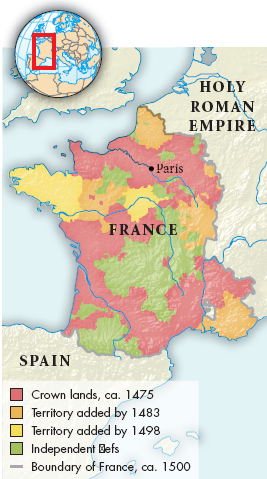France

The Expansion of France, 1475–1500
The Black Death and the Hundred Years’ War left France drastically depopulated, commercially ruined, and agriculturally weak. Nonetheless, the ruler whom Joan of Arc had seen crowned at Reims, Charles VII (r. 1422–1461), revived the monarchy and France. Charles reconciled the Burgundians and Armagnacs (ahr-muhn-YAKZ), who had been waging civil war for thirty years. By 1453, French armies had expelled the English from French soil except in Calais. Charles reorganized the royal council, giving increased influence to lawyers and bankers, and strengthened royal finances through taxes on certain products and on land.
By establishing regular companies of cavalry and archers — recruited, paid, and inspected by the state — Charles created the first permanent royal army anywhere in Europe. His son Louis XI (r. 1461–1483) improved on Charles’s army and used it to control the nobles’ separate militias and to curb urban independence. The army was also employed in 1477 when Louis conquered Burgundy after the death of its ruler Charles the Bold. Three years later, the extinction of the house of Anjou with the death of its last legitimate male heir brought Louis the counties of Anjou, Bar, Maine, and Provence.
Two further developments strengthened the French monarchy. The marriage of Louis XII (r. 1498–1515) and Anne of Brittany added the large western duchy of Brittany to the state. Then King Francis I and Pope Leo X reached a mutually satisfactory agreement about church and state powers in 1516. The new treaty, the Concordat of Bologna, recognized the French ruler’s right to select French bishops and abbots. French kings thereafter effectively controlled the policies of church officials in the kingdom.
